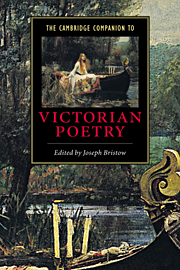Book contents
- Frontmatter
- 1 Reforming Victorian poetry: poetics after 1832
- 2 “The Lady of Shalott” and the critical fortunes of Victorian Poetry
- 3 Experimental form in Victorian poetry
- 4 The dramatic monologue
- 5 Victorian meters
- 6 Victorian poetry and historicism
- 7 Victorian poetry and science
- 8 Victorian poetry and religious diversity
- 9 The Victorian poetess
- 10 The poetry of Victorian masculinities
- 11 Aesthetic and Decadent poetry
- 12 Victorian poetry and patriotism
- 13 Voices of authority, voices of subversion: poetry in the late nineteenth century
- Glossary
- Guide to Further Reading
- Index
5 - Victorian meters
Published online by Cambridge University Press: 28 May 2006
- Frontmatter
- 1 Reforming Victorian poetry: poetics after 1832
- 2 “The Lady of Shalott” and the critical fortunes of Victorian Poetry
- 3 Experimental form in Victorian poetry
- 4 The dramatic monologue
- 5 Victorian meters
- 6 Victorian poetry and historicism
- 7 Victorian poetry and science
- 8 Victorian poetry and religious diversity
- 9 The Victorian poetess
- 10 The poetry of Victorian masculinities
- 11 Aesthetic and Decadent poetry
- 12 Victorian poetry and patriotism
- 13 Voices of authority, voices of subversion: poetry in the late nineteenth century
- Glossary
- Guide to Further Reading
- Index
Summary
In Victorian poetry we see a proliferation of poetic forms, departing from eighteenth-century heroic couplets and neoclassical odes, and further developing the Romantic revival of ballads, sonnets, and blank verse into increasingly refined and rarefied metrical experiments. Alongside the English fashion in Italian sonnets, French stanzaic forms, Germanic accentual verse, and various kinds of dialect poetry - as well as a fascination with the literary recreation of songs, ballads, hymns, refrains, and other musical forms - there was a return to meters inspired by ancient Greek and Latin poetry. Victorian prosody - the study of meter - also became increasingly elaborate: in addition to counting the number of stresses or syllables per line, as in the tradition of English accentual-syllabic verse, prosodists tried to measure the length (or “quantity”) of syllables in English according to the tradition of classical quantitative verse. The publication of historical surveys and theoretical treatises on meter rose dramatically throughout the Victorian period, ranging from Edwin Guest's A History of English Rhythms (1838, revised 1882) to George Saintsbury's History of English Prosody (1906-10), and peaking mid-century with the New Prosody of Coventry Patmore and his contemporaries, and again at the end of the century, with the circulation of numerous polemical pamphlets and scholarly debates about meter.
- Type
- Chapter
- Information
- The Cambridge Companion to Victorian Poetry , pp. 89 - 113Publisher: Cambridge University PressPrint publication year: 2000
- 19
- Cited by



